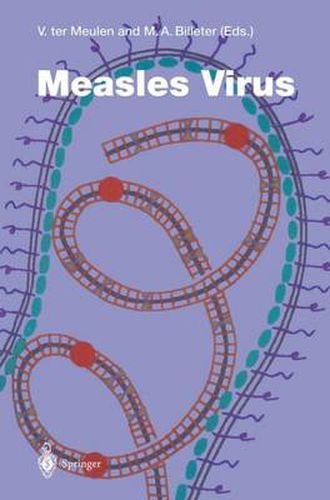Readings Newsletter
Become a Readings Member to make your shopping experience even easier.
Sign in or sign up for free!
You’re not far away from qualifying for FREE standard shipping within Australia
You’ve qualified for FREE standard shipping within Australia
The cart is loading…






This title is printed to order. This book may have been self-published. If so, we cannot guarantee the quality of the content. In the main most books will have gone through the editing process however some may not. We therefore suggest that you be aware of this before ordering this book. If in doubt check either the author or publisher’s details as we are unable to accept any returns unless they are faulty. Please contact us if you have any questions.
Measles, also called the greatest killer of children in history, still annually affects about 50 million individuals and causes close to a million deaths primarily in developing countries. Before the advent of measles vaccine some 30 years ago, these figures were roughly three times higher. Attenuated measles virus (MV) strains, all quite closely related to the original Edmonston isolate, have a very good record as a safe and highly efficacious vaccine and have brought down the measles toll in industrialized countries to almost negligible levels. However, recent outbreaks in the USA and Europe have again brought the measles problem to public attention. Sadly enough, these outbreaks were more instrumental in inducing activities to drastically reduce and hopefully finally eradicate measles than were the ten thousand times higher number of victims in developing countries. To reach this goal, as detailed in this volume, apparently it is not enough to of the existing vaccine as was the rigorously enforce use case with smallpox eradication: the intricacies of measles disease phenomena, in particular the generalized immune suppression which favors secondary infections, require more basic knowledge of the virus-host interactions and probably the development of new vaccines for special applications such as first immunizations of very young infants in developing countries.
$9.00 standard shipping within Australia
FREE standard shipping within Australia for orders over $100.00
Express & International shipping calculated at checkout
Stock availability can be subject to change without notice. We recommend calling the shop or contacting our online team to check availability of low stock items. Please see our Shopping Online page for more details.
This title is printed to order. This book may have been self-published. If so, we cannot guarantee the quality of the content. In the main most books will have gone through the editing process however some may not. We therefore suggest that you be aware of this before ordering this book. If in doubt check either the author or publisher’s details as we are unable to accept any returns unless they are faulty. Please contact us if you have any questions.
Measles, also called the greatest killer of children in history, still annually affects about 50 million individuals and causes close to a million deaths primarily in developing countries. Before the advent of measles vaccine some 30 years ago, these figures were roughly three times higher. Attenuated measles virus (MV) strains, all quite closely related to the original Edmonston isolate, have a very good record as a safe and highly efficacious vaccine and have brought down the measles toll in industrialized countries to almost negligible levels. However, recent outbreaks in the USA and Europe have again brought the measles problem to public attention. Sadly enough, these outbreaks were more instrumental in inducing activities to drastically reduce and hopefully finally eradicate measles than were the ten thousand times higher number of victims in developing countries. To reach this goal, as detailed in this volume, apparently it is not enough to of the existing vaccine as was the rigorously enforce use case with smallpox eradication: the intricacies of measles disease phenomena, in particular the generalized immune suppression which favors secondary infections, require more basic knowledge of the virus-host interactions and probably the development of new vaccines for special applications such as first immunizations of very young infants in developing countries.